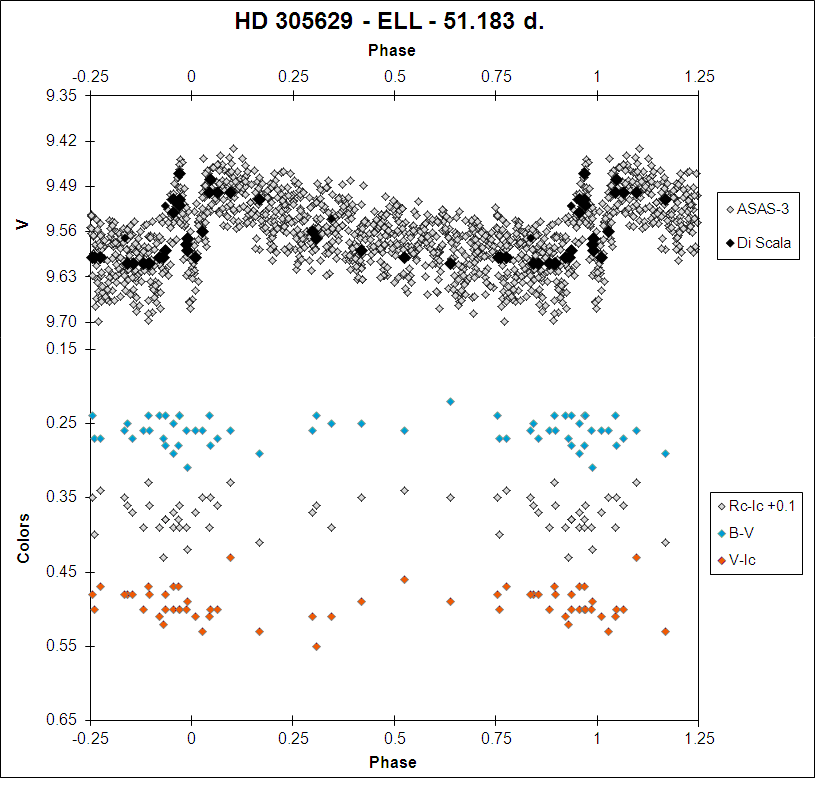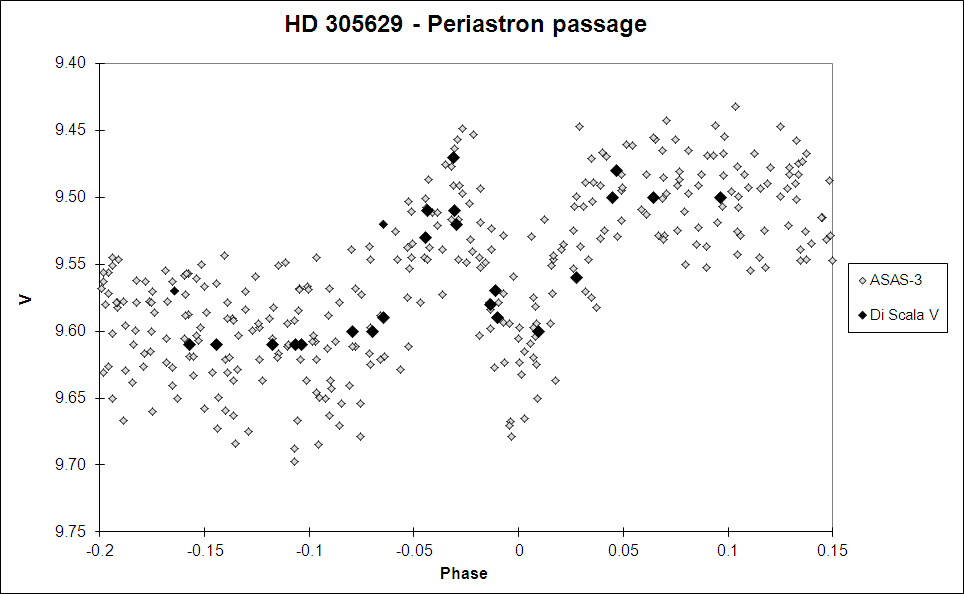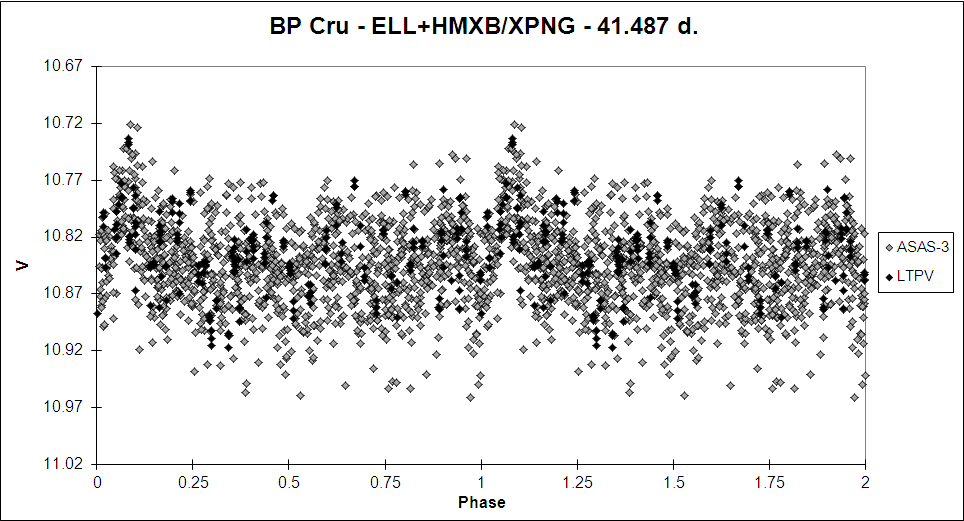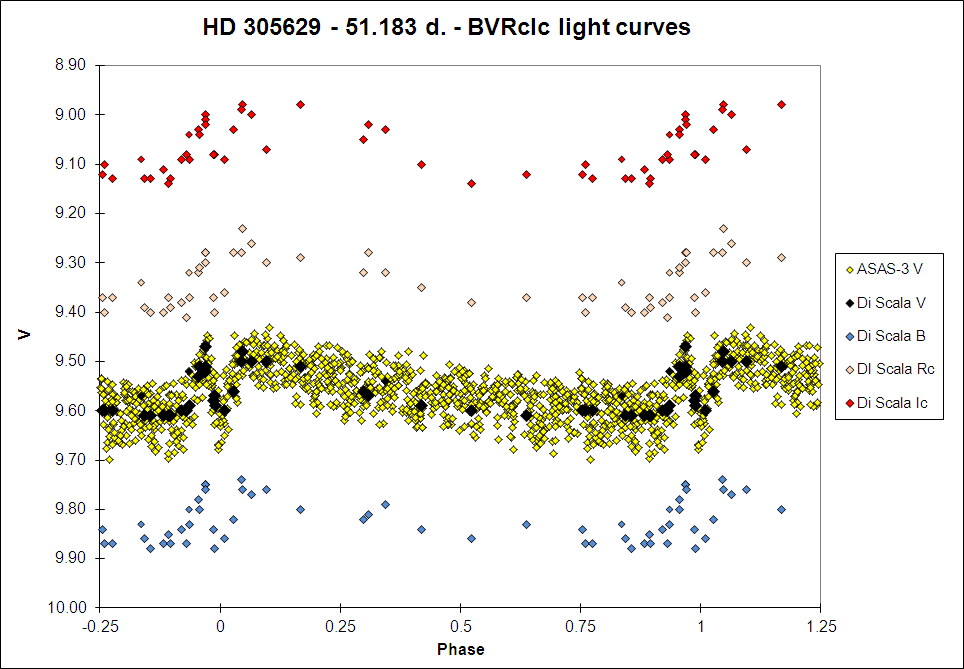|
Peremennye Zvezdy (Variable Stars) 33, No. 7, 2013 Received 24 August; accepted 30 August.
|
Article in PDF |
HD 305629, an Eccentric Ellipsoidal System
S. A. Otero1,2, G. Di Scala3,4
- Buenos Aires, Argentina
- American Association of
Variable Star Observers, Cambridge, MA, USA; e-mail:
sebastian@aavso.org
- Carnes Hill Observatory, Sydney,
Australia; e-mail: lgdiscala@bigpond.com
- Astronomical Association of Queensland, Australia
| The new variable star HD 305629, with a Cepheid-like light curve, is demonstrated, from our optical observations and ASAS-3 data, to actually be an ellipsoidal variable star on a highly eccentric orbit. It resembles the X-ray variable star BP Cru. HD 305629 deserves further observations in other wavelengths. |
1. Introduction
During a systematic search of variable stars in the publicly
available ASAS-3 database (Pojmanski 2002), apparent variability
was found in the star HD 305629 (10![]() 51
51![]() 34
34![]() 35,
-60
35,
-60![]() 47
47![]() 57
57
![]() 4, J2000.0; Fig. 1). The ASAS-3 light curve
of the target is partially contaminated by HD 305630, a B1V star
with
4, J2000.0; Fig. 1). The ASAS-3 light curve
of the target is partially contaminated by HD 305630, a B1V star
with ![]() ,
, ![]() , and
, and ![]() lying
lying ![]() away.
As a result of this, the scatter in the ASAS-3 observations is
high. The light curve shape folded with a period of 51
away.
As a result of this, the scatter in the ASAS-3 observations is
high. The light curve shape folded with a period of 51![]() 18
showed a rapid rise to maximum and a slower decline which at first
sight made us think of a bright long period classical Cepheid as a
possible classification. However, the spectral type in the
literature was B8 (Nesterov et al. 1995). The amplitude was also
barely above 0
18
showed a rapid rise to maximum and a slower decline which at first
sight made us think of a bright long period classical Cepheid as a
possible classification. However, the spectral type in the
literature was B8 (Nesterov et al. 1995). The amplitude was also
barely above 0![]() 1 which is too low for such a type but that
could be explained by the presence of a bright companion reducing
the amplitude. The B8 spectrum could belong to that companion.
Tycho-2 photometry converted to the
1 which is too low for such a type but that
could be explained by the presence of a bright companion reducing
the amplitude. The B8 spectrum could belong to that companion.
Tycho-2 photometry converted to the ![]() system using Bessell's
tables (Bessell 2000) gives
system using Bessell's
tables (Bessell 2000) gives ![]() and
and ![]() . 2MASS
. 2MASS ![]() color is 0.25, which indicates reddening. After closer
examination, a rapid drop in brightness right at the star's
maximum peak was found, but the scatter in the light curve casted
some doubts about its reality.
color is 0.25, which indicates reddening. After closer
examination, a rapid drop in brightness right at the star's
maximum peak was found, but the scatter in the light curve casted
some doubts about its reality.
 |
Fig. 1.
Finding chart showing the variable and the
comparison and check stars. North is up. The image scale is
1
|
Since a Cepheid would be redder and would display color changes,
![]() photometry (see next section) was performed to check
for the presence of those changes and also to determine accurate
photometry for HD 305629 without the interference of the
photometry (see next section) was performed to check
for the presence of those changes and also to determine accurate
photometry for HD 305629 without the interference of the ![]() companion.
companion.
2. Observations
All observations were carried out from December, 2011 to April,
2013 using a Meade 12-inch Schmidt-Cassegrain GPS telescope
located at Carnes Hill Observatory. The camera used was an SBIG
ST9 XE utilizing SBIG filter wheel and Custom Scientific
![]() photometric filters. Photometry was performed using
AIP4WIN 2.0 with apertures carefully selected to exclude
surrounding stars. The same apertures were used for all
measurements to ensure consistency. Magnitudes and colors are
transformed to the standard system using Southern E-field stars
E4103, E4106, and E4108. Corrections for primary and secondary
extinction were applied in determining the magnitudes of the
comparison and check stars. Plate solutions were obtained for the
field using MPO Canopus software (version 9.3.1.0) to confirm the
coordinates of each of the stars of interest. The comparison stars
(identified in the finding chart in Fig. 1) used were:
photometric filters. Photometry was performed using
AIP4WIN 2.0 with apertures carefully selected to exclude
surrounding stars. The same apertures were used for all
measurements to ensure consistency. Magnitudes and colors are
transformed to the standard system using Southern E-field stars
E4103, E4106, and E4108. Corrections for primary and secondary
extinction were applied in determining the magnitudes of the
comparison and check stars. Plate solutions were obtained for the
field using MPO Canopus software (version 9.3.1.0) to confirm the
coordinates of each of the stars of interest. The comparison stars
(identified in the finding chart in Fig. 1) used were:
Comp star = HD 305630;
![]()
![]() (J2000);
(J2000); ![]() ;
; ![]() ;
; ![]() ;
;
![]() . Check star = TYC 8957-3762-1;
. Check star = TYC 8957-3762-1;
![]()
![]() (J2000);
(J2000); ![]() ;
; ![]() ;
; ![]() ;
;
![]() .
.
3. Results
The light and color curves of HD 305629 from our observations are presented in Fig. 2.
 |
Fig. 2.
The |
After the ![]() magnitude of our target was determined, we corrected
the ASAS-3 dataset
(http://www.astrouw.edu.pl/cgi-asas/asas_variable/105134-6048.0,asas3,51.183,3015.64,
magnitude of our target was determined, we corrected
the ASAS-3 dataset
(http://www.astrouw.edu.pl/cgi-asas/asas_variable/105134-6048.0,asas3,51.183,3015.64,
500,500) from the light contamination and the resulting difference
in amplitude was only 0![]() 05. The mean resulting colors were:
05. The mean resulting colors were:
![]() ;
; ![]() ;
; ![]() ;
; ![]() . The
relatively faint
. The
relatively faint ![]() (9.34) and
(9.34) and ![]() (9.07) magnitudes
indicated that the Cepheid plus B8 companion hypothesis was not
possible. Also there were no color changes revealing pulsational
behavior.
(9.07) magnitudes
indicated that the Cepheid plus B8 companion hypothesis was not
possible. Also there were no color changes revealing pulsational
behavior.
Combining our dataset with the ASAS-3 observations, we determined
the light elements:
The star varies between
 |
Fig. 4. A zoomed in portion of the light curve around periastron passage showing the two maxima and two minima. |
Among B-type stars, we find one similar example in our Galaxy, the
binary system BP Cru made up of a B2Ia supergiant and an X-ray
pulsar in an eccentric 41![]() 487 orbit. This is an improved
period for the system based on ASAS-3 and LTPV (Manfroid et al.
1991) data; see the light curve in Fig. 5. BP Cru undergoes X-ray
outbursts just before periastron passage (Watson et al. 1982).
487 orbit. This is an improved
period for the system based on ASAS-3 and LTPV (Manfroid et al.
1991) data; see the light curve in Fig. 5. BP Cru undergoes X-ray
outbursts just before periastron passage (Watson et al. 1982).
 |
Fig. 5. Light curve of the ellipsoidal high mass X-ray binary BP Cru. The scatter in the phase plot is due to mean magnitude changes due to the binary interaction. The epoch of minimum is HJD 2445442.7. |
Observations of HD 305629 in other wavelengths are encouraged.
Acknowledgments: This study was possible thanks to the funding and equipment provided by the Astronomical Association of Queensland, Australia. We also made use of the VizieR database operated at the Centre de Données Astronomiques (Strasbourg) in France.
References:
Bessell, M. S., 2000, Publ. Astron. Soc. Pacific, 112, 961
Manfroid, J., Sterken, C., Bruch, A., et al., 1991, Astron. Astrophys. Suppl. Ser., 87, 481
Nesterov, V. V., Kuzmin, A. V., Ashimbaeva, N. T., et al., 1995, Astron. Astrophys. Suppl. Ser., 110, 367
Pojmanski, G., 2002, Acta Astron., 52, 397
Soszynski, I., Udalski, A., Kubiak, M., et al., 2004, Acta Astron., 54, 347
Watson, M. G., Warwick, R. S., Corbet, R. H. D., 1982, Monthly Not. Roy. Astron. Soc., 199, 91
